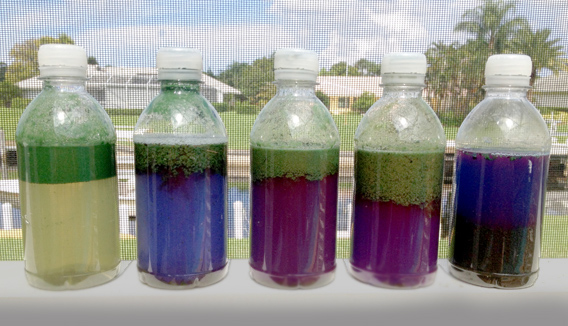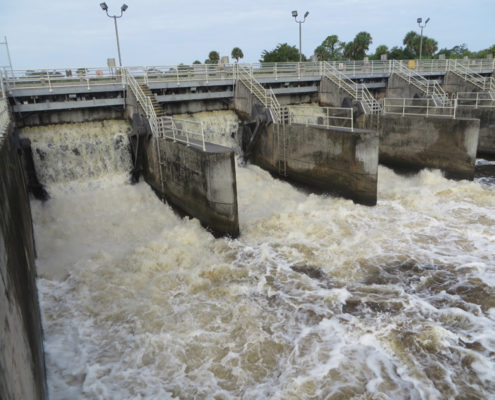The Indian River Lagoon, a natural wonder once called the “Cradle of the Ocean” is suffering from decades of misuse and neglect.
Life in the Indian River Lagoon is under threat from discharges of polluted fresh water pouring through drainage systems along its length, nutrient loading resulting in harmful algae blooms, turbidity and sediment accumulation, and the loss of important ecosystem features such as seagrass meadows, oyster beds, and mangrove habitat.
The Indian River Lagoon is now facing an ecological crisis.
Estuaries have been called the “cradle of the ocean” since nearly three quarters of fish, crustacean and shellfish species begin or spend part of their lives there. For centuries, the shallow estuarine waters, marshes, seagrass meadows, and mangrove prop roots of the Indian River Lagoon provided food sources and hiding places for many creatures, supporting the food web for animals large and small, including human beings. Today, life in and around the Lagoon is being threatened by numerous anthropogenic causes.
Damage to the Indian River Lagoon comes from many sources:
- Nutrient loading, harmful algae, and bacterial contamination
- Stormwater runoff containing toxic substances, fertilizer, pesticides, and particulates
- Increased drainage due to the enlargement of the Lagoon’s watershed
- Turbidity, muck, and sediment accumulation in the Lagoon
Nutrient loading, harmful algae, and bacterial contamination
Nutrients such as nitrogen and phosphorus from agriculture and lawn fertilization promote an overgrowth of algae in the water column, decreasing the amount of light available to seagrasses for photosynthesis. The overgrowth of algae leads to a decrease in oxygen in the water through decomposition when the algae dies, making it hard for fish and other creatures to breathe. Increased nutrients also spur the growth of blue-green algae, or cyanobacteria, which releases toxins into the water that are dangerous for animals and humans alike. Most nutrients enter the Lagoon through the system of canals built for flood control, but residential and commercial septic systems also discharge nutrients and bacterial contamination into the Lagoon.
Stormwater runoff containing toxic substances, fertilizer, pesticides, and particulates
Before human interference, most rainfall in the Lagoon’s watershed fell onto naturally vegetated upland habitats, where much of the precipitation was taken up by plants – the remainder percolated slowly through permeable soils into the lagoon. Rainfall was naturally scrubbed of contaminants through the percolation process, and was relatively clean when it entered the lagoon. Today, impermeable surfaces – roads, parking lots, and rooftops – cover much of the area where this natural cleaning process once occurred. During rain events, large volumes of stormwater runoff flow rapidly into swales, canals and ditches, carrying sediments, decomposed organic matter, nutrients, heavy metals, viruses, bacteria, and other pollutants directly into the Lagoon where they can sicken wildlife.
Increased drainage due to the enlargement of the Lagoon’s watershed
The Lagoon’s historic watershed covered about 572,000 acres. However, the creation of drainage canals for increased agricultural production and flood control artificially enlarged the watershed to more than 1.4 million acres. For example, fresh water that historically drained into the St. Johns River and Lake Okeechobee is now shunted into the Lagoon through a managed canal system, and the Lagoon receives freshwater discharges from two-and-a-half times more land than it did a century ago. The result has been a dramatic decline in water quality, and in seagrass health. Fresh water discharges also alter the salinity of the Lagoon, affecting the growth of oyster beds which filter and clean the water.
Turbidity, muck, and sediment accumulation in the Lagoon
The Indian River Lagoon once had a sandy bottom, with a small accumulation of organic detritus originating from shoreline and aquatic vegetation. The bottom of the lagoon is now covered in a layer of fine silt and sediment called muck. Muck results from decayed plant material and poor erosion control, and is deposited in the Lagoon through stormwater runoff and the canal system that drains the Lagoon’s watershed. Muck harms fish, shellfish, and seagrass. Because it is easily stirred up and re-suspended in the water column by boats and storms, it causes elevated turbidity and decreased light penetration. Muck deposits frequently contain high levels of heavy metals such as copper, lead, and zinc, which can be toxic to marine life – their effects range from illness to reproductive failure and mortality.
Source: https://www.sms.si.edu/IRLSpec/Seagrass_Emerging_Issues.htm


